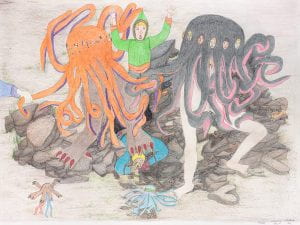Today’s lesson involves just looking at and interpreting some of Shuvinai’s other artworks.
Shuvinai produces her work at Kinngait Studios, the art arm of the West Baffin Eskimo Cooperative. She did not attend formal art school. Instead, she worked alongside her elders to study and learn by observing them work and create art in the studio. The studio is a very busy place in this northern area. Many inhabitants around it like to participate in art-making and the studio is the host to all of them. People who come to visit Kinngait are careful to visit the studio and often make art purchases there. It is a win-win situation when an outsider purchases a work of art from a Kinngait local.
Here is a sound recording telling the history of the Kinngait studio, the ship that would regularly sail into Kinngait, and the artists and people who lived there:
https://soundcloud.com/user-939264564-352476585/art-and-ashoona-family-final
Have a look at this work by Shuvinai:
This one is “Untitled”. It is made with coloured pencils and sharpie pen.
- What creatures are in this artwork?
- What do you think is happening in this artwork?
- Who are these people?
- Why would there be two heads inside one hood?
- What are the two drawings about in this artwork?
Inspired by films, comic books and television, she creates her drawings using pen and ink, pencil crayons and markers. Ashoona’s drawings are filled with her memories of the Arctic, historical stories she heard from her elders and daily realities of life in Kinngait, combined with worlds from within her imagination that create her own unique take on northern life, and many of her drawings feature a bird’s eye view. Each meticulously detailed drawing contains a story within a story—a surprise, an observation or an unexpected twist.
This one is called “Attack of the Tentacle Monsters”. It is made with pencil crayons.
- What creatures are in this artwork?
- What do you think is happening in this artwork?
- Who are these creatures and where did they come from?
- Why would there be six heads inside one tentacle monster hood?
- What are the two parts of this work that you notice in particular?
Indigenous people include plants, animals, rocks and places in their reckoning of kin. When an indigenous person refers to “all my relations” these include the land, the trees, the rocks, the water wherein they live and were born and raised. This idea – that humans are related to non-humans and places, is important and timely for current political struggles over rights to resources and land. The idea that humans are related to non-humans and places is, however, not a familiar one to the outside observer. I don’t consider myself to be related to a rock in a park, or to a patch of bulrushes growing along the river. For Kinngait people though, this is their understanding.
This one is called “Earth Transformations”. It is made with a white fineliner pen and pencil crayons on black paper.
Shuvinai’s images are intriguing and engaging, sometimes astounding and occasionally frightening. What to make of Earth Transformations, a drawing that features a creature with a large blue-and-green globe for a head, arms and hands composed of strings of similar but smaller planets, a torso draped in octopuslike tentacles, and human legs with blue toenails? And how to read this creature’s companion, a parka-clad Inuit man holding up a picture of a scene in which a hunter with a rifle sits behind a blind that is also an artist’s canvas? (The title is not really clue – Shuvinai did not name this artwork, an art curator did.) Shuvinai doesn’t like to talk about what her works might “mean”. She produces them without plan or precept, seeming to draw her images directly from her unconscious mind.
- Who do you think the globe-headed octopus character is? Is it nice? Or menacing? Where did it come from? What does it want?
- Who is the blue parka’d character? What is this person saying to the globe-headed character?
- Who is the person in the white parka? Are these three characters friends or enemies? What is their relationship?
- Why are there so many circles in this work? What do the circles represent to you?
- Why do you think this artwork is on display in the very prestigious Vancouver Art Gallery?
That’s it for this lesson. Please complete your answers to all three sets of questions -questions about “Untitled”, “Attack of the Tentacle Monsters” and about “Earth Transformations”. There are not necessarily “right” answers to these. The questions seek out what YOU think. I look forward to reading your answers. Please email them to me by Thursday May 7.
Until then, stay well.


